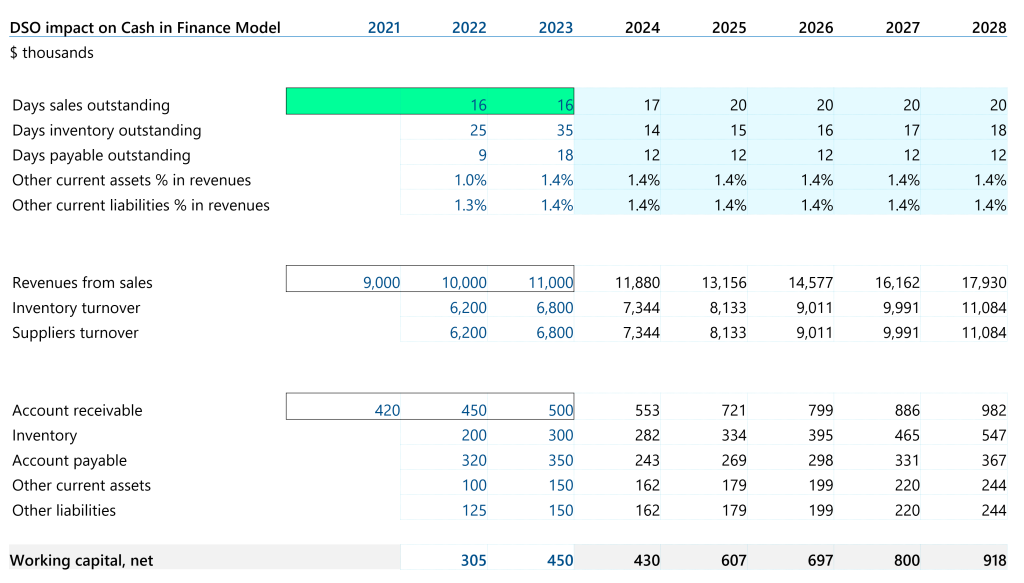What is DSO
The typical duration a company takes to collect money from customers.
Introduction to Day Sales Outstanding
Day Sales Outstanding (DSO) stands as a critical metric in the financial lexicon, quantifying the average duration it takes for a company to collect payments post-sale. This metric’s significance lies in its ability to offer a lucid insight into the effectiveness of a firm’s accounts receivable management and cash flow efficacy.
Calculating DSO
The formula for calculating Day Sales Outstanding (DSO) is:
Days Sales Outstanding = (Average Accounts Receivable / Revenues from Sales) x Number of Days in Accounting Period
Average Accounts Receivable: (AR Balance in from the beginning of the period + AR Balance in from the ending of the period) / 2

Example of DSO calculation
Suppose Company XYZ has the following financial figures over a year:
Average Accounts Receivables: $40,000
Revenues from Sales: $360,000
Number of Days in the Period: 365 days (1 year)
Using the DSO formula:
DSO = (40,000 / 360,000) × 365 = 41
This result means that on average, Company XYZ takes approximately 41 days to collect money from customers.
Applications in Financial Modeling and Analysis
DSO is an important tool in financial modeling and analysis, particularly in the context of accounts receivable management. Here are some key applications of DSO in financial modeling and analysis:
- Working Capital Management: DSO is a crucial component of working capital management. By tracking DSO, a company can assess its efficiency in collecting accounts receivable. Lower DSO indicates faster collections, which can free up cash for other purposes.
- Cash Flow Forecasting: DSO plays a significant role in cash flow forecasting. Companies can use historical DSO data to predict future cash flows more accurately. This information is vital for planning and making informed financial decisions.
- Credit Policy Assessment: DSO can help in evaluating the effectiveness of a company’s credit policies. If DSO is increasing over time, it may indicate that the company is extending credit to riskier customers or needs to improve its credit collection processes.
- Performance Benchmarking: DSO is used for benchmarking a company’s performance against industry standards and competitors. It provides insights into how efficient a company is in managing its accounts receivable compared to peers.
- Credit Risk Assessment: Companies can assess the credit risk associated with their customers by analyzing DSO. Higher DSO may indicate that a company is exposed to greater credit risk, especially if customers are consistently slow in paying their invoices.
Download this calculator and calculate DSO and how much change in DSO impacts cash and net working capital

High DSO Implications
Cash Flow Constraints
High DSO indicates that the company takes a longer time to collect payments from customers, tying up its cash in accounts receivable. This can lead to cash flow constraints, making it challenging to meet short-term financial obligations, pay suppliers, or invest in growth opportunities.
Risk of Bad Debts
A prolonged DSO can increase the risk of bad debts. Customers who delay payments for an extended period may eventually default on their payments, resulting in write-offs and financial losses.
Reduced Liquidity
High DSO can reduce a company’s liquidity, making it less resilient to economic downturns or unexpected expenses. This lack of liquidity can limit the company’s ability to respond to market changes or take advantage of strategic opportunities.
Low DSO Implications
Improved Cash Flow
Low DSO indicates that the company collects payments from customers quickly, leading to improved cash flow. This enables the company to meet its financial obligations promptly and reduces the need for external financing.
Reduced Credit Risk
A low DSO suggests that the company’s credit policies are effective in minimizing the risk of bad debts. Customers are more likely to pay promptly when they know the company has strict credit and collections procedures.
Enhanced Liquidity
Low DSO enhances a company’s liquidity, providing financial flexibility to respond to market opportunities, invest in growth, and weather economic challenges more effectively.
Lower Financing Costs
With better cash flow and reduced reliance on external financing, a company with low DSO can minimize financing costs and improve its profitability.
Strategies to Reduce DSO
To mitigate high DSO, companies often implement stringent credit policies and turn to technological solutions like automated invoicing systems. These strategies aim to accelerate payment processes and tighten credit terms.
Challenges in Managing DSO
Common pitfalls in managing DSO include inconsistent credit policy enforcement and inadequate customer credit analysis. Mitigating these risks involves regular review of credit policies and enhanced customer due diligence.
The Future of DSO Management
Emerging trends in DSO management point towards an increased reliance on predictive analytics, enabling companies to forecast potential delays in payments and take preemptive action.
Conclusion
In summarizing,
the scrutiny of Day Sales Outstanding (DSO) extends far beyond a mere financial metric; it embodies a comprehensive gauge of a company’s fiscal health and operational efficiency.
The reduction and effective management of DSO are pivotal for enhancing liquidity and ensuring sustainable business growth.
This comprehensive analysis underscores the multifaceted nature of DSO, offering a deep dive into its calculation, impact, management strategies, and future trends, all crucial for finance professionals and business leaders aiming to fortify their financial foundations.
Ready to take your financial modeling skills to the next level?
Dive deep into our Financial Modeling Course and master advanced techniques, including DSO analysis, portfolio optimization, and risk management. With a comprehensive curriculum, hands-on experience, and expert instructors, you’ll gain the expertise needed to advance your career in finance.

